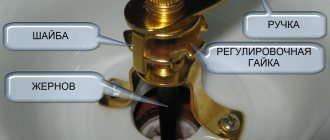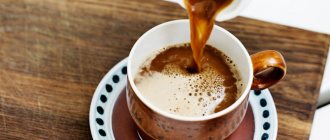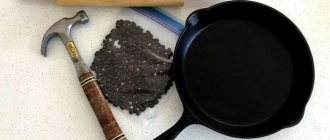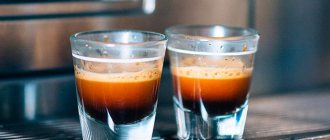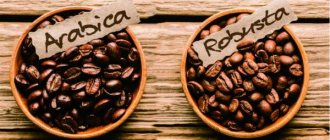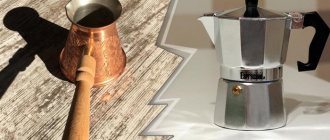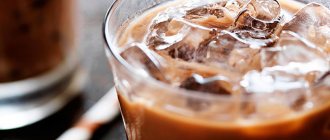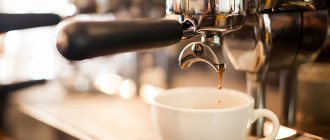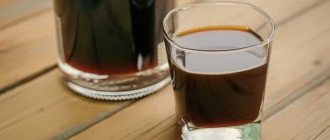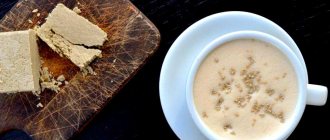After purchasing a professional coffee grinder, the company inevitably comes up with the question of correctly setting the coffee grinder for medium roast. Properly adjusted grinding is the basis for making espresso with a rich bouquet of taste and aroma. It is not always clear how to set the grinding correctly, but this important task does not require much time and effort if you follow a few rules.
Any barista knows that grinding affects the aroma and quality of the drink , so it is important for a coffee professional to be able to competently change the settings of a coffee grinder built into a coffee machine or standing alone. Without this, professional success of a barista is impossible. The choice of grinding is influenced by the method of brewing the drink and external factors: percentage of air humidity, room temperature, atmospheric pressure level. atmospheric conditions.
If you do not change the grind after the percentage of moisture in the air increases, the drink will become bitter because the particles swell, fit closer together and lengthen the brewing time of the coffee. In the case of a decrease in air humidity, the same mistake will lead to the appearance of an unpleasant sourness in the drink, since the coffee beans lose moisture, the distance between the particles becomes larger, and the extraction time of flavoring substances is shortened (not the entire bouquet of taste and aroma is boiled out of the grain).
About settings
There are two types of settings for making coffee:
- Basic.
- Auxiliary.
The main settings are available in all modern machines. Additional adjustments allow you to apply other parameters. In this case, initially:
- A thorough (control) cleaning of the passageways of milk and grain mixture is carried out. Special means are used for this.
- It is necessary to carry out control measurements. The goal is to identify hidden preset errors.
- A check is performed and the correct settings are set with their subsequent control.
Let's dwell on settings such as temperature, extraction, water, bookmark, and so on.
Tips for adjusting grinding
- 1.Change only one variable at a time.
- Change only one parameter that affects the final drink, and leave all the rest unchanged. Parameters such as water temperature, coffee dose and brewing method should remain constant.
- Start by adjusting the grind you previously used.
- When purchasing a new coffee grinder, set the grind to the middle position. This is called the "basic setting". Initially, the manufacturer sets the grinding degree to medium by default. The degree of grinding must be changed in such a way that it is: if the grinding is too fine, set larger values; if too rough, lower values.
- Make small changes to different grinder settings.
- After the first cup with the “base setting”, you need to grind two more cups of coffee. If you grind the first cup in step 20, then grind the next ones in steps 19 and 21. One division of the coffee grinder disk is approximately equal to 2 - 3 seconds. extraction. This division price makes it possible to minimize coffee consumption by adjusting the grinding. To change the settings, you need to move the grinding dial in the desired direction a few notches.
- Before tasting, decide on your taste preferences.
- Try the coffee, recording your sensations of aromas and try the coffee slowly.
- Blends and single varieties are brewed differently and have different aromas and tastes.
- Brew several test batches of coffee.
- At a coffee shop, ask a professional barista to grind some of the coffee beans you bought and use it as a reference when making coffee at home. When learning a new skill, cultivate patience.
The grind setting level depends on the coffee grinder model, so the exact position of the millstones can only be determined experimentally.
Once the setup is complete, there is no need to turn off the coffee grinder. Let it run for a while to remove coffee particles from the machine.
To maximize the preservation of essential oils, grinding the beans must be done 5-10 minutes before the brewing process.
Post Views: 4,050
How to properly set up a coffee machine
Setting up a coffee machine includes several technical regulations.
- Temperature setting.
After complete decalcification, which ensures 100% throughput of all systems, we turn our attention to extraction, which directly depends on the passage time of the water and its temperature. Operating temperature parameters must correspond to 86-960. The setting is carried out using the corresponding button on the coffee machine.
For a specific type of drink (latte, cappuccino, espresso), you can set one of the programmed temperatures:
- Low.
- Standard.
- High.
In professional machines, this mode is set in degrees:
- For each type of coffee separately.
- There is a general settings mode.
Turning the knob counterclockwise by 1 notch reduces the temperature of the liquid by a degree and vice versa.
About extraction, setting time and grinding degree of grain
On average, the extraction process takes from 8 to 20 seconds. If less time is spent, the incomplete process is called underextraction (the beans do not have time to fully release caffeine to the water). With an increase in processing time, this is over-extraction (the drink acquires a bitter taste).
Extraction, which is performed manually, will take longer if the grain is ground minimally and vice versa.
Medium-fine grind: espresso.
Be careful here! It will be hard. Of all the methods, espresso is the most capricious in terms of grinding, so it makes sense to consider it in more detail.
And don't forget about statistics! The share of espresso-based coffee drinks in any coffee shop stubbornly strives for 100%. No matter how you conjure the sand, no matter how you tinker with the alternative, the mass consumer still needs espresso.
Preferably with sugar, milk, cream, syrup, sprinkled with chocolate chips... be that as it may, espresso is the basis of all cappuccinos, lattes, long blacks and flatwhites.
And if the espresso is frankly worthless, then the cappuccino won’t work either. It is a fact.
“Espresso is a drink prepared in an espresso machine with a volume of 25±5 milliliters from water pressed under a pressure of 9 bar for 25±5 seconds through a compacted layer of medium-fine coffee at a temperature of 85-98°C.” © World Barista Championship
Professionals adjust the coffee grinder several times a day. Coffee is a very good adsorbent. It absorbs foreign odors and moisture. Therefore, at the end of the day, when the humidity in the room increases, the grinding needs to be “coarsened” (made larger). The degree of grinding has a tremendous impact on the quality of the drink. The barista's technique when preparing the drink remains the same; the only thing we “play with” is grinding. If we grind very finely, the coffee will drip and taste very bitter (overextraction). If the grind is too coarse, the coffee will spill too quickly and all the components that make up the taste of the coffee will not have time to transfer into the drink, and the espresso will be watery (underextraction). In both cases, the cream on the surface will be unstable. We need to look for a middle ground!
The degree of grinding has an incredible impact on the taste of coffee. By adjusting the coffee grinder, you can remove excess bitterness or sourness and achieve more or less saturation. Of course, other factors also influence the preparation of coffee in an espresso machine: the quality of the bean, the temperature in the group, the quality of the water, the hands of the barista, his mood and much more. But other things being equal, it is the degree of grinding that is the value that should regulate all other factors. Honestly, it's easier to change the grind three times a day than a barista every week!
To ensure optimal extraction speed, it is enough to adjust the grind size, leaving both the dosage and the force applied during packaging constant. The barista's manipulations may not change, but the grind settings of the coffee grinder must be constantly adjusted and adjusted.
When adjusting the grinding, the following several factors must be taken into account: the degree of room humidity and temperature, changes in the season (heat, dryness, raininess, wind, snowy weather, and, accordingly, the level of room heating, operation of the air conditioner, humidifier, etc.). Also, do not forget about the freshness of the grain itself and the millstones of coffee grinders, which also have their own expiration date.
Let me explain why seemingly insignificant circumstances have such a huge impact. If it is too humid outside or indoors, the coffee granules begin to swell, pressing closer together, thereby increasing the extraction time of the espresso, making it bitter. Low humidity has the opposite effect: the distance between the granules increases, the coffee cooks faster, its density becomes less, and the taste begins to sour. If the grind is too fine, the coffee will be bitter, and if the grind is coarse, it will be watery, unsaturated with a thin layer of cream.
To determine the quality of the grind, you will need an accurate scale and a stopwatch to determine the coffee extraction time. Record the time from the moment you turn on the espresso until it ends: if the preparation time takes less than 22 seconds, then the grind is coarse, and if longer than 28, the grind is too fine. The ideal extraction time for espresso is 25 seconds. Deviations according to specialty coffee standards are ±3 seconds and ±3 milliliters from the ideal; ±5 is acceptable in commercial standards. Great if you measure temperature and TDS, but much better if you can judge the appearance and taste of espresso like a pro. I have never met a customer in a coffee shop with a refractometer in his pocket (industrial espionage and secret quality control do not count), but many more people can distinguish good coffee from bad than you think.
You should be aware of when exactly you need to change the settings on your coffee grinder, depending on the following changes in the atmosphere and room temperature:
Professional coffee grinders are adjusted using a grinding degree adjustment dial, which is located between the body and the hopper (hopper for coffee beans). If a finer grind is required, the disk (only when the knives are turned on - the coffee grinder may be blocked!) is turned several notches towards the inscription FIN or (FINE). If a coarser grind is required, the disc must be turned (permissible with the knives turned off) towards the inscription GROS or (COARSE, GROSSA).
The price of dividing the adjusting disk of a coffee grinder corresponds (on average in a hospital) to approximately two to three seconds of extraction - taking this fact into account, you can minimize coffee consumption when adjusting the grinding. Changing the settings usually takes several steps of the grinding control in one direction or another.
Let's see how one of the world's most popular coffee grinders, the Mahlkönig K30, is set up, as shown by WBC champion American Michael Phillips:
Most of all, the change in grinding is influenced by changes in humidity, temperature and environmental pressure. As the humidity increases, the grinding begins to become bitter (since the granules, swelling, fit closer to each other, increasing the extraction time), and when the humidity decreases, on the contrary, it begins to sour (the natural moisture of the coffee is lost and the reverse process occurs: the distance between the granules increases and water spills faster, without having time to brew espresso).
Before you start changing the settings, you need to grind the coffee for one serving and brew exactly 25 ml of espresso, measuring the extraction time. If the extraction time was less than 22 seconds. - this means that the grinding is coarse, more than 28 seconds. - thin.
See how to care for your Mazzer coffee grinder:
Working with home coffee grinders is, of course, easier. Here are the recommendations for the grinding scale of the fairly popular and high-quality Gaggia MDF coffee grinder:
It is necessary to configure not only individual devices, but also coffee grinders built into automatic coffee machines. Initially, the manufacturer sets the average grinding degree by default, often coarser than necessary. It is necessary to change the degree of grinding according to the following algorithm: if the grinding is too fine, set larger values; if too rough, lower values. Remember that the new grind setting will take effect after three to four cups of coffee have been brewed.
Fine grind: oriental coffee.
East is a delicate matter! We use the finest grind to make coffee in a cezve (Turk, Ibrik). This is the only way in which the coffee is served with grounds, but there should be as little of it in the cup as possible. Coffee particles should not creak on your teeth.
I know a lot of people who like to brew coffee in a cup using finely ground coffee; this method is usually called “Polish style” or “Warsaw style”. Starbucks, which has launched retail sales of pre-ground finely-fine natural coffee as an alternative to instant coffee, recommends doing the same.
Pay attention to this chart! It clearly shows the distribution of ground coffee particles depending on their size. The higher the peak and steeper the slopes, the more uniform the grind. The flatter the valley, the higher the scatter in particle sizes. Small ones will be overcooked, large ones will be undercooked. In general, the grain will be spoiled no matter how you cook it.
Getting the grinding to “dust” is the most difficult thing to do. Not all coffee grinders, even professional ones, do this kind of grinding. Homemade knife (propeller) type coffee grinders, at first glance, make such grinding, but very unevenly, which is very noticeable on the graph, and besides, they also greatly burn the coffee with long and fast rotation.
It seems easier to do the correct grinding in a coffee shop that has the right coffee grinder, but...finely ground coffee stores much worse than coarsely ground coffee. This is understandable: the total surface area increases with grinding, and the larger the surface, the faster all those aromas that we would like to feel over the cup disappear. To preserve the flavor and aroma of your coffee longer, store it in a cool, dry place in an airtight container away from spices.
The best thing is to buy a coffee grinder.
Buy a coffee grinder. To have something to configure 
The best place to start on your journey to the perfect cup is by purchasing a coffee grinder. This is much more important than all the Turkish pour-over coffee makers combined. Good, fresh beans and a coffee grinder are what you really can’t do without.
It doesn’t have to be a fancy monster right away; you can first use a good hand mill, for example Hario. Modern manual coffee grinders are almost no different from those that appeared in the 15th century: the beans are poured between two corrugated metal disks through a funnel, one of the disks is rigidly fixed, and the other is rotated by the same handle that turns the screw when adding coffee.
Of the good electric coffee grinders, I would recommend the Barazza line. This is already an adult, even semi-professional instrument. It is absolutely possible to achieve good espresso with its help, but it is almost ideal as an alternative. Here's a review of the best home coffee grinders from a reputable and independent source:
A little more about Baratza Forté – AP (All Purpose), in my humble opinion this is the best coffee grinder in the line:
How to use a coffee grinder correctly
The machine settings depend on the degree of roasting of the beans.
Setting the specified parameters is carried out only when the unit is running. If this rule is not followed, the rotary switch may be damaged.
Adjustment wheel.
Coffee machines that have adjustments of 6-10 positions are most accurately adjusted.
Experts do not recommend setting up equipment for minimal grinding of grains. There is practically no effect, but you can cause problems associated with the brewing unit.
The quality of the settings is indicated by the output cake. If it comes out in tablet form, the machine operates within the specified parameters.
Common coffee making mistakes
Caramelized, flavored beans cannot be used in coffee machines. Additives coat the coffee grinder millstones with a film, and the grinding suffers. They are difficult to clean; often you have to disassemble the entire assembly. It is also undesirable to use ground coffee with additives.
A typical mistake is incorrectly setting the grinding degree in a coffee machine for a specific roast of beans. Dark prefers coarser grinding and vice versa. The universal solution remains medium settings.
Bottled mineralized water with added calcium, fluorine, and iodine has a bad effect on the quality. Take simple filtered water without chlorine, color, or odor.
How much coffee to add and liquid dosage
These indicators, although indirectly, affect the process of extraction of coffee beans. Before work, you should read the manufacturer's recommendations, which are indicated in the documentation.
Tablet after tamping coffee
If we talk about volumes, then it should be understood that for regular espresso a volume of 30-60 ml is required. For a double serving this figure will be 60-120 ml. You need 7 grams per serving. For double – 12 grams.
In modern coffee machines, the portion of liquid is adjusted independently.
How to measure a dose of coffee?
There are several ways to measure coffee for one preparation:
- approximately. An extremely unsuccessful method for a beginner, which is often used for preparation in a French press or drip coffee maker. Only an experienced barista will be able to regularly obtain stable results when using this method;
- using scales. They can be purchased at jewelry stores or coffee shops. The step of such a device is 0.1 g. It is better to measure the first dose according to a standard recipe, then adapt its size to suit you;
- at the click of the bunker. The measurement error in this case will be 0.2 g. In some recipes, it can seriously affect the taste.
Grinding coffee beans is an important step in preparing an invigorating drink. If you strictly follow the technology of this process, the finished result will always be the same - tasty and aromatic coffee.
About the dosage of the product and the sequence of actions
Modern coffee machines have a three-letter indication (designation) on the display or operating panel:
- Abbreviation "C": coffee.
- Abbreviation "M": milk.
- Abbreviation "S": milk with foam.
The machines have a program with which you can set the feeding sequence. For example, first a drink is poured into a cup, and then a milk mixture, or vice versa.
In a manual operation, you decide what is fed initially. There are no strict restrictions or prohibitions.
Calibrate your grinder or grinding fines.
A long time ago, when coffee was just entering the life of mankind, the beans were pounded in a mortar and pestle. Using this method, it is almost impossible to achieve a fine grind, but to prepare traditional Ethiopian or Bedouin coffee, fine grinding was not required.
The grinding procedure was lengthy, required considerable force and did not provide the necessary grinding uniformity. Over time, the Arabs invented the first mechanical coffee grinder with a rotating handle . For more than five centuries, this mechanical product has not undergone significant changes. In 1665, the coffee grinder was improved by a London blacksmith, and it was patented only in 1798. April 3 is the birthday of Coffee Grinder.
Why adjust the grind?
Setting up a coffee grinder is an important, delicate and responsible moment. Coffee beans are very capricious, and ground coffee is even more capricious. Inhomogeneity of grinding, changes in humidity or temperature can lead to completely different results. Just had delicious coffee - and suddenly, out of the blue, or a sour, watery liquid, or a viscous, bitter and astringent liquid...
But they didn’t change the grinding! The coffee grinder was set up in the service department (in a store, a barista friend came to visit) a month (year) ago, and no one touched it! Common situation? Have you seen the touching naive stickers that say “Turk 3, espresso 4, filter 7”? So, none of this works. Correctly adjusted grinding can only happen here and now; yesterday’s settings are invalid.
The grind size is not a constant value, so it is impossible to adjust the coffee grinder once and for all.
Scared? Relax, this is only true for professional espresso grinders; home methods are less demanding. Let's figure out what the main grinding gradations are and how to adjust the grinding.
For each coffee preparation method, you need to select your own grind. The duration of brewing, temperature, pressure are also important... All these parameters need to be balanced so that from 18% to 25% of the soluble beneficial components found in the grain are transferred into the drink. This is 1.15 to 1.35 TDS (concentration of solids measured by a refractometer) as measured by the instruments in the cup. Then the coffee can be rich and tasty. There, in the central yellow square of the SCAE brew chart:
Very coarse grind: French press.
We use the coarsest grind for a French press (plunger, or French bistro coffee maker). The particle size should be about 0.8 mm. With coarse grinding, the extraction time (transfer of soluble substances into the drink) is 4 minutes. We can use medium-coarse grinding for this brewing method, but then we reduce the time to 3 minutes. If you follow these rules, your coffee will be great.
Coffee, properly brewed in a French press, retains the maximum of beneficial, flavoring and aromatic substances. This coffee has a dense body, a buttery richness of oils, and a great aroma. Many professionals use a French press in order to properly evaluate all the flavor and aromatic features of the grain.
Coarse grind: filter coffee makers.
“Coffee for cupping should be ground so that 70-75% remains on a number 20 sieve, with an opening diameter of 850mμ.” © Specialty Coffee Cupping Protocols
The second place in terms of particle size is occupied by a filter machine, a drip coffee maker. A lot of coffee is brewed, the temperature is high, the result is expected as soon as possible. Everything is logical. Very tasty coffee, by the way. The main thing is delicious, fresh Arabica, and not an espresso mixture pre-ground six months ago at the factory from the nearest supermarket.
The same grinding fineness is used when brewing coffee using the open method in a cup using the Brazilian system. It is the Brazilian cupping and filter that are used as the basis for all coffee tastings. This is perhaps the most canonized and well-documented grinding and brewing standard; refer to the regulations of COE, WCE, SCAE, SCAA.
Do you brew coffee in a cup at home? Do it like the entire coffee elite of the planet does! 5.5 g of coffee per 100 ml of unboiled water 92°C, brew for 4 minutes, remove the layer of coffee from the surface with a spoon, drink without sugar.
Medium-coarse grind: pour-overs of all stripes.
Of all the pourovers, the coarsest grind is usually used for Chemex and Clever, as they contain infusion elements, which increases extraction. The Chemex has very thick filter paper, so the coffee pours out slowly. Clover generally fixes the water in the funnel with a special valve. That is why not everyone considers these two devices to be the pour-over method. That’s what they write on the menu: “Chemex XX coins; Purover of XX coins.” And everything is clear to everyone.
The most popular pourovers are Hario V60, Melitta, Kalita Wave. Hario is especially popular, I'm not original, I also like him the most. Or maybe it's just a matter of habit. Alternative methods of brewing coffee allow for quite large variations in profiles, the main thing is that it is tasty. Different shapes of funnels and technology for folding filters, different coffees, different tastes - all this leaves an imprint on the grind size. There is room for creativity here! We increase the temperature - increase the grinding, lower the temperature - reduce the grinding. For large funnels, the grind is usually coarser than for small ones.
Approximately the same medium-coarse degree of grinding is usually used for siphons, although many experts argue that siphons like coarse grinding, as for cupping. The same applies to all drippers with fabric and metal filters; in order to get a clean drink without sediment, the grind should be coarser, as for cupping or French. Those who like it stronger make the grind finer, as with V60.
Medium grind: for all occasions.
It’s not for nothing that marketing specialists call this grinding universal. It can be used for a geyser-type coffee maker (moka), most inexpensive home manual espresso machines (carob coffee makers).
Aeropress likes a grind coarser than espresso, but finer than pour over. At the same time, it has a fairly wide field for experiments with time, temperature and grinding fineness. We check the correctness of the selected grinding by extraction. If the drink turns out rich and tasty, everything is OK.
Almost all coffee that is sold ground has just such an average grind. Therefore, the vast majority of coffee lovers use this type of coffee always and everywhere: in a filter coffee maker, in a Turkish coffee pot... and, of course, in a cup. This, of course, is wrong and tasteless. But this is life! And she is imperfect.
How dosage is set
After determining the priority of coffee, milk or formula, the next process is to set the dosage of the ingredients. Almost all modern models have a special o with 14 divisions. From minimum feed to maximum performance.
The leftmost division is the minimum coffee supply. The rightmost division is the maximum water output. The adjustable increment is 5 ml. In this case, the range ranges from 20 to 500 milliliters. Then everything is simple: the yield indicators of milk and milk formula are set.
About the quality of milk and its temperature
Modern devices have a temperature level that can be:
- For cold (warm) milk it should not exceed 40-45 degrees.
- For moderately warm milk - 60-65 degrees.
- Hot milk - 68-70 degrees.
Temperature indicators are allowed to be set only when the device is running using a special faucet with manual adjustment. To increase the volume of milk and raise the temperature, you need to turn the tap clockwise. Turning counterclockwise will have the opposite effect.
The supply of milk foam is adjusted in the same way.
Checking the operation of the coffee making machine
If the coffee maker is set up correctly and the grinding is carried out in accordance with the manufacturer’s instructions, the cake at the exit should have the form of a “tablet”.
If the coffee maker is unstable, you must call a technician or contact a service center.
Setting up a coffee machine is not as complicated a process as it might seem. The main thing is to follow the manufacturer's instructions and follow the sequence of operations. Each type of coffee is a new platform for correctly setting up and setting the operating modes of the coffee machine.
When to change your coffee grinder settings
The coffee grinder settings must be changed in the following cases:
- Changing the type of coffee.
- If environmental conditions have changed: the air temperature has become higher or lower, the humidity level or atmospheric pressure has changed.
- If the coffee grinder knives have become dull (determined by uneven grinding). Knives require sharpening once a year.
There is no coffee grinder that will produce a completely uniform grind. In most cases, the ground beans will contain larger particles and coffee dust mixed in. To obtain high-quality coffee, you can sift the ground beans through a metal sieve of the required diameter to filter out particles that are too large or small.
When air humidity rises, coffee becomes bitter. As the humidity level decreases, it acquires a sour taste.
